Financial Statement Analysis: Financial Management and Ratio Usage
VerifiedAdded on 2023/06/14
|10
|2191
|390
Report
AI Summary
This report provides a comprehensive overview of financial management, emphasizing its importance in controlling a firm's financial activities. It details the significance of financial statements in assessing a business's financial position and market share. The report includes an income statement and balance sheet created using Excel, along with a description of various financial ratios, such as profitability, efficiency, and liquidity ratios, derived from a case study. These ratios are used to compare past and present performance, determine profitability, and assess solvency. Furthermore, the report describes the process of improving a business's financial performance through marketing strategies and efficient asset utilization, highlighting the role of financial decision-making in ensuring the business's survival and growth. Desklib offers this report and other study resources to aid students in their learning.

3005
Paraphrase This Document
Need a fresh take? Get an instant paraphrase of this document with our AI Paraphraser
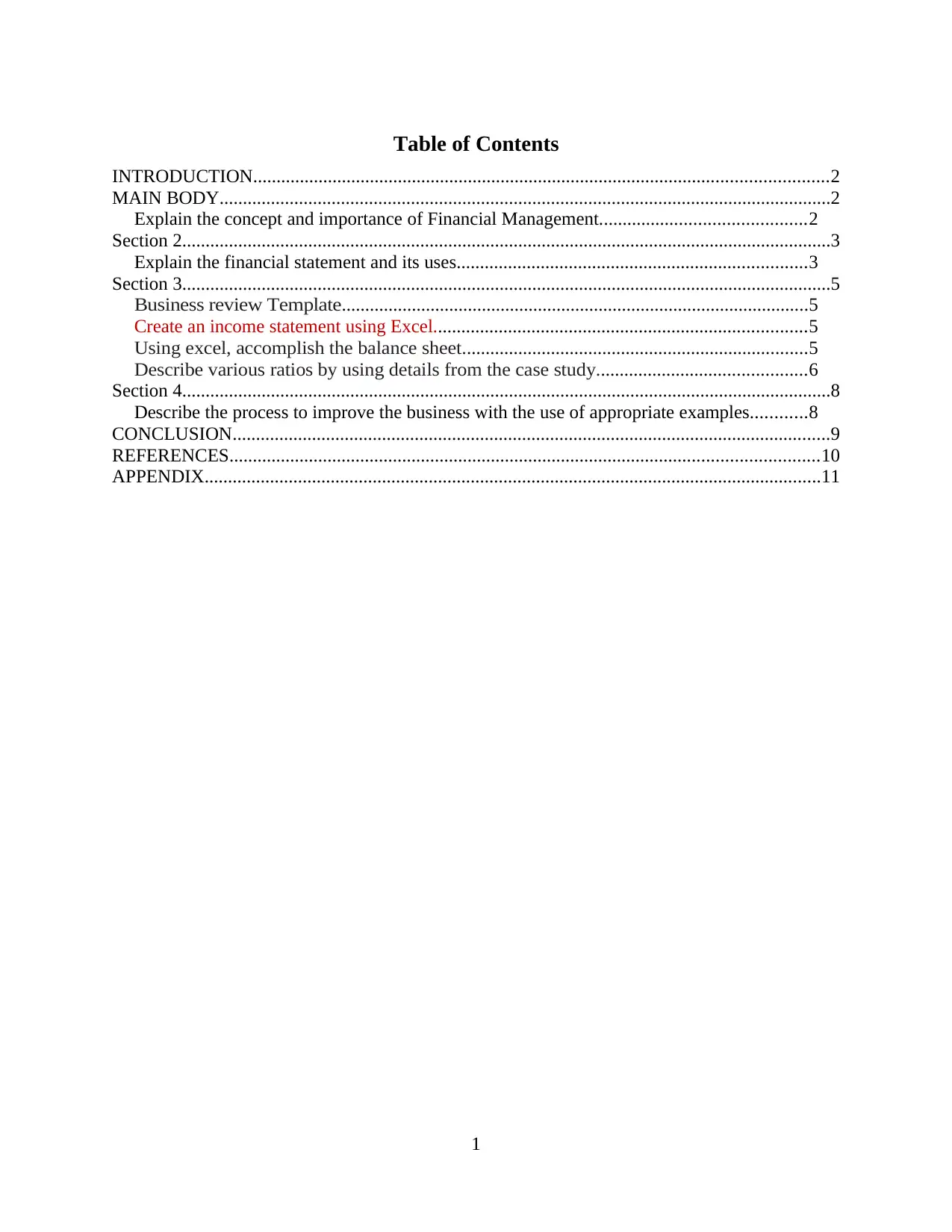
Table of Contents
INTRODUCTION...........................................................................................................................2
MAIN BODY...................................................................................................................................2
Explain the concept and importance of Financial Management............................................2
Section 2...........................................................................................................................................3
Explain the financial statement and its uses...........................................................................3
Section 3...........................................................................................................................................5
Business review Template....................................................................................................5
Create an income statement using Excel................................................................................5
Using excel, accomplish the balance sheet..........................................................................5
Describe various ratios by using details from the case study.............................................6
Section 4...........................................................................................................................................8
Describe the process to improve the business with the use of appropriate examples............8
CONCLUSION................................................................................................................................9
REFERENCES..............................................................................................................................10
APPENDIX....................................................................................................................................11
1
INTRODUCTION...........................................................................................................................2
MAIN BODY...................................................................................................................................2
Explain the concept and importance of Financial Management............................................2
Section 2...........................................................................................................................................3
Explain the financial statement and its uses...........................................................................3
Section 3...........................................................................................................................................5
Business review Template....................................................................................................5
Create an income statement using Excel................................................................................5
Using excel, accomplish the balance sheet..........................................................................5
Describe various ratios by using details from the case study.............................................6
Section 4...........................................................................................................................................8
Describe the process to improve the business with the use of appropriate examples............8
CONCLUSION................................................................................................................................9
REFERENCES..............................................................................................................................10
APPENDIX....................................................................................................................................11
1
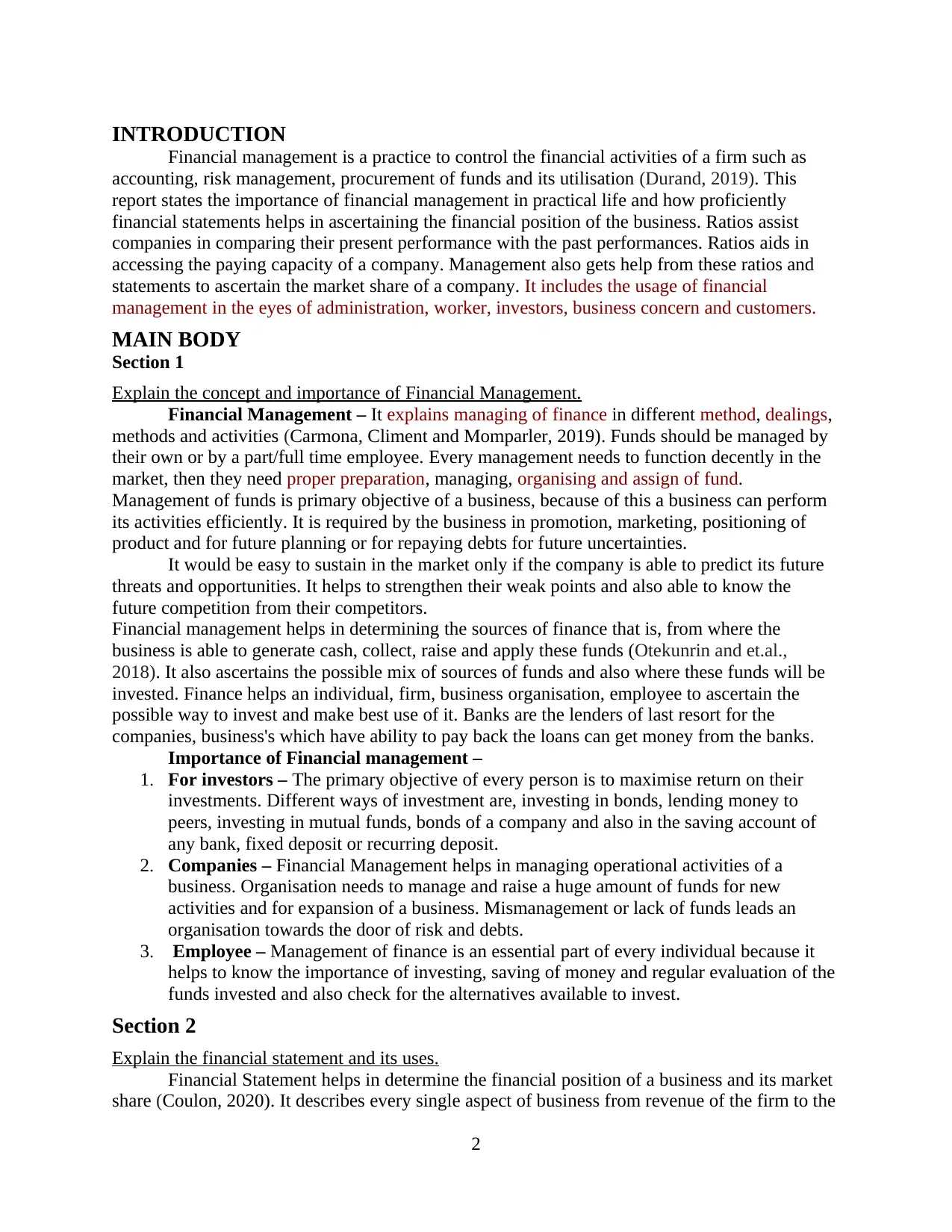
INTRODUCTION
Financial management is a practice to control the financial activities of a firm such as
accounting, risk management, procurement of funds and its utilisation (Durand, 2019). This
report states the importance of financial management in practical life and how proficiently
financial statements helps in ascertaining the financial position of the business. Ratios assist
companies in comparing their present performance with the past performances. Ratios aids in
accessing the paying capacity of a company. Management also gets help from these ratios and
statements to ascertain the market share of a company. It includes the usage of financial
management in the eyes of administration, worker, investors, business concern and customers.
MAIN BODY
Section 1
Explain the concept and importance of Financial Management.
Financial Management – It explains managing of finance in different method, dealings,
methods and activities (Carmona, Climent and Momparler, 2019). Funds should be managed by
their own or by a part/full time employee. Every management needs to function decently in the
market, then they need proper preparation, managing, organising and assign of fund.
Management of funds is primary objective of a business, because of this a business can perform
its activities efficiently. It is required by the business in promotion, marketing, positioning of
product and for future planning or for repaying debts for future uncertainties.
It would be easy to sustain in the market only if the company is able to predict its future
threats and opportunities. It helps to strengthen their weak points and also able to know the
future competition from their competitors.
Financial management helps in determining the sources of finance that is, from where the
business is able to generate cash, collect, raise and apply these funds (Otekunrin and et.al.,
2018). It also ascertains the possible mix of sources of funds and also where these funds will be
invested. Finance helps an individual, firm, business organisation, employee to ascertain the
possible way to invest and make best use of it. Banks are the lenders of last resort for the
companies, business's which have ability to pay back the loans can get money from the banks.
Importance of Financial management –
1. For investors – The primary objective of every person is to maximise return on their
investments. Different ways of investment are, investing in bonds, lending money to
peers, investing in mutual funds, bonds of a company and also in the saving account of
any bank, fixed deposit or recurring deposit.
2. Companies – Financial Management helps in managing operational activities of a
business. Organisation needs to manage and raise a huge amount of funds for new
activities and for expansion of a business. Mismanagement or lack of funds leads an
organisation towards the door of risk and debts.
3. Employee – Management of finance is an essential part of every individual because it
helps to know the importance of investing, saving of money and regular evaluation of the
funds invested and also check for the alternatives available to invest.
Section 2
Explain the financial statement and its uses.
Financial Statement helps in determine the financial position of a business and its market
share (Coulon, 2020). It describes every single aspect of business from revenue of the firm to the
2
Financial management is a practice to control the financial activities of a firm such as
accounting, risk management, procurement of funds and its utilisation (Durand, 2019). This
report states the importance of financial management in practical life and how proficiently
financial statements helps in ascertaining the financial position of the business. Ratios assist
companies in comparing their present performance with the past performances. Ratios aids in
accessing the paying capacity of a company. Management also gets help from these ratios and
statements to ascertain the market share of a company. It includes the usage of financial
management in the eyes of administration, worker, investors, business concern and customers.
MAIN BODY
Section 1
Explain the concept and importance of Financial Management.
Financial Management – It explains managing of finance in different method, dealings,
methods and activities (Carmona, Climent and Momparler, 2019). Funds should be managed by
their own or by a part/full time employee. Every management needs to function decently in the
market, then they need proper preparation, managing, organising and assign of fund.
Management of funds is primary objective of a business, because of this a business can perform
its activities efficiently. It is required by the business in promotion, marketing, positioning of
product and for future planning or for repaying debts for future uncertainties.
It would be easy to sustain in the market only if the company is able to predict its future
threats and opportunities. It helps to strengthen their weak points and also able to know the
future competition from their competitors.
Financial management helps in determining the sources of finance that is, from where the
business is able to generate cash, collect, raise and apply these funds (Otekunrin and et.al.,
2018). It also ascertains the possible mix of sources of funds and also where these funds will be
invested. Finance helps an individual, firm, business organisation, employee to ascertain the
possible way to invest and make best use of it. Banks are the lenders of last resort for the
companies, business's which have ability to pay back the loans can get money from the banks.
Importance of Financial management –
1. For investors – The primary objective of every person is to maximise return on their
investments. Different ways of investment are, investing in bonds, lending money to
peers, investing in mutual funds, bonds of a company and also in the saving account of
any bank, fixed deposit or recurring deposit.
2. Companies – Financial Management helps in managing operational activities of a
business. Organisation needs to manage and raise a huge amount of funds for new
activities and for expansion of a business. Mismanagement or lack of funds leads an
organisation towards the door of risk and debts.
3. Employee – Management of finance is an essential part of every individual because it
helps to know the importance of investing, saving of money and regular evaluation of the
funds invested and also check for the alternatives available to invest.
Section 2
Explain the financial statement and its uses.
Financial Statement helps in determine the financial position of a business and its market
share (Coulon, 2020). It describes every single aspect of business from revenue of the firm to the
2
⊘ This is a preview!⊘
Do you want full access?
Subscribe today to unlock all pages.

Trusted by 1+ million students worldwide
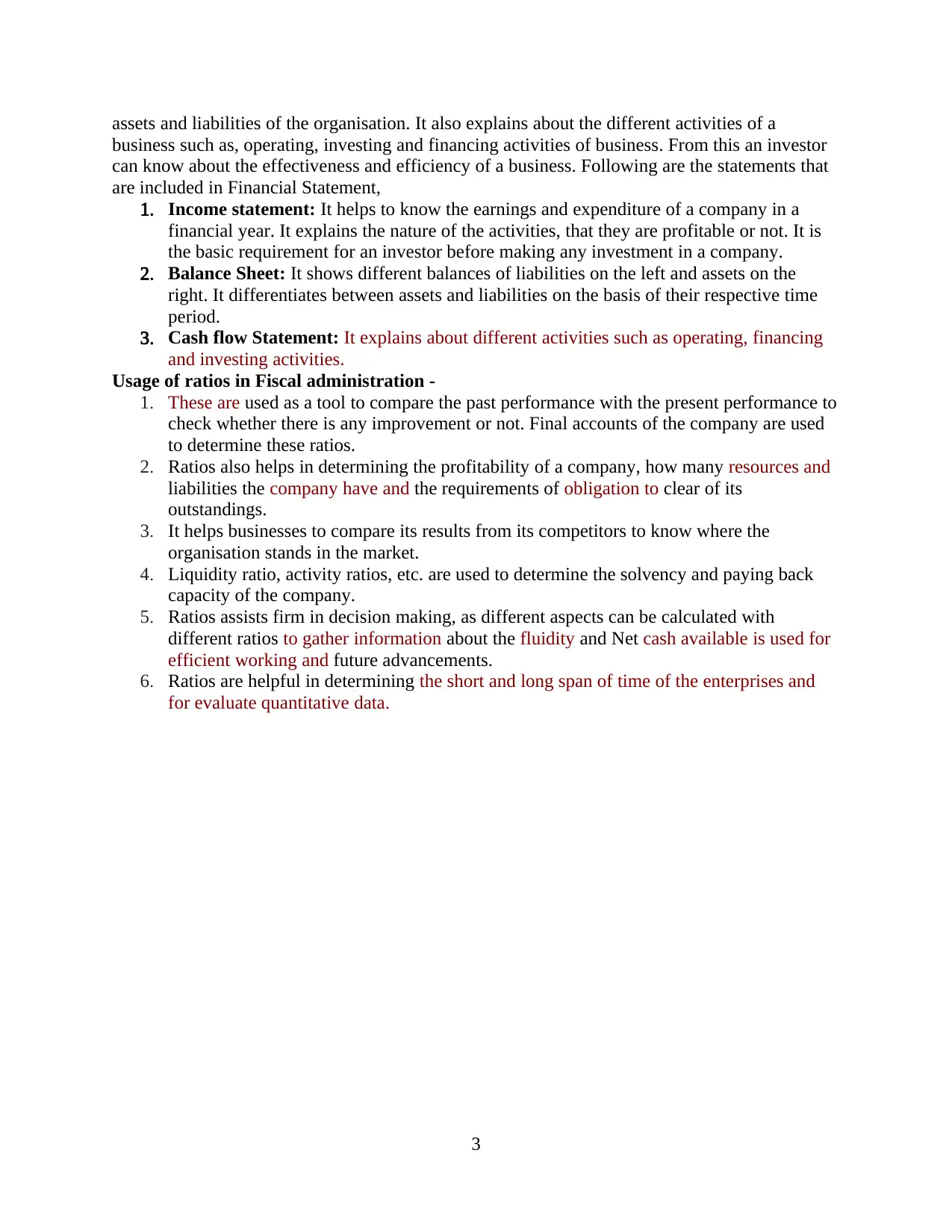
assets and liabilities of the organisation. It also explains about the different activities of a
business such as, operating, investing and financing activities of business. From this an investor
can know about the effectiveness and efficiency of a business. Following are the statements that
are included in Financial Statement,
1. Income statement: It helps to know the earnings and expenditure of a company in a
financial year. It explains the nature of the activities, that they are profitable or not. It is
the basic requirement for an investor before making any investment in a company.
2. Balance Sheet: It shows different balances of liabilities on the left and assets on the
right. It differentiates between assets and liabilities on the basis of their respective time
period.
3. Cash flow Statement: It explains about different activities such as operating, financing
and investing activities.
Usage of ratios in Fiscal administration -
1. These are used as a tool to compare the past performance with the present performance to
check whether there is any improvement or not. Final accounts of the company are used
to determine these ratios.
2. Ratios also helps in determining the profitability of a company, how many resources and
liabilities the company have and the requirements of obligation to clear of its
outstandings.
3. It helps businesses to compare its results from its competitors to know where the
organisation stands in the market.
4. Liquidity ratio, activity ratios, etc. are used to determine the solvency and paying back
capacity of the company.
5. Ratios assists firm in decision making, as different aspects can be calculated with
different ratios to gather information about the fluidity and Net cash available is used for
efficient working and future advancements.
6. Ratios are helpful in determining the short and long span of time of the enterprises and
for evaluate quantitative data.
3
business such as, operating, investing and financing activities of business. From this an investor
can know about the effectiveness and efficiency of a business. Following are the statements that
are included in Financial Statement,
1. Income statement: It helps to know the earnings and expenditure of a company in a
financial year. It explains the nature of the activities, that they are profitable or not. It is
the basic requirement for an investor before making any investment in a company.
2. Balance Sheet: It shows different balances of liabilities on the left and assets on the
right. It differentiates between assets and liabilities on the basis of their respective time
period.
3. Cash flow Statement: It explains about different activities such as operating, financing
and investing activities.
Usage of ratios in Fiscal administration -
1. These are used as a tool to compare the past performance with the present performance to
check whether there is any improvement or not. Final accounts of the company are used
to determine these ratios.
2. Ratios also helps in determining the profitability of a company, how many resources and
liabilities the company have and the requirements of obligation to clear of its
outstandings.
3. It helps businesses to compare its results from its competitors to know where the
organisation stands in the market.
4. Liquidity ratio, activity ratios, etc. are used to determine the solvency and paying back
capacity of the company.
5. Ratios assists firm in decision making, as different aspects can be calculated with
different ratios to gather information about the fluidity and Net cash available is used for
efficient working and future advancements.
6. Ratios are helpful in determining the short and long span of time of the enterprises and
for evaluate quantitative data.
3
Paraphrase This Document
Need a fresh take? Get an instant paraphrase of this document with our AI Paraphraser
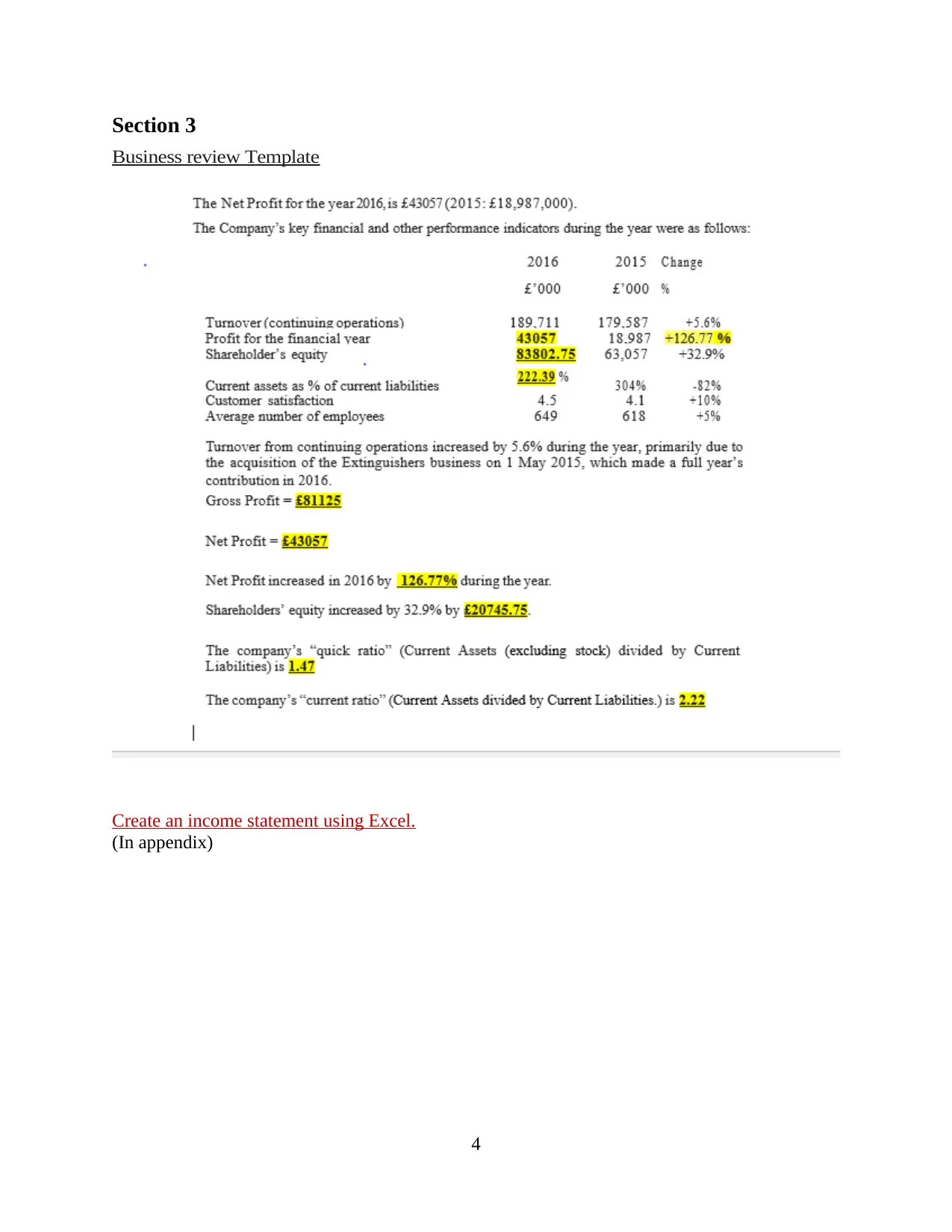
Section 3
Business review Template
Create an income statement using Excel.
(In appendix)
4
Business review Template
Create an income statement using Excel.
(In appendix)
4
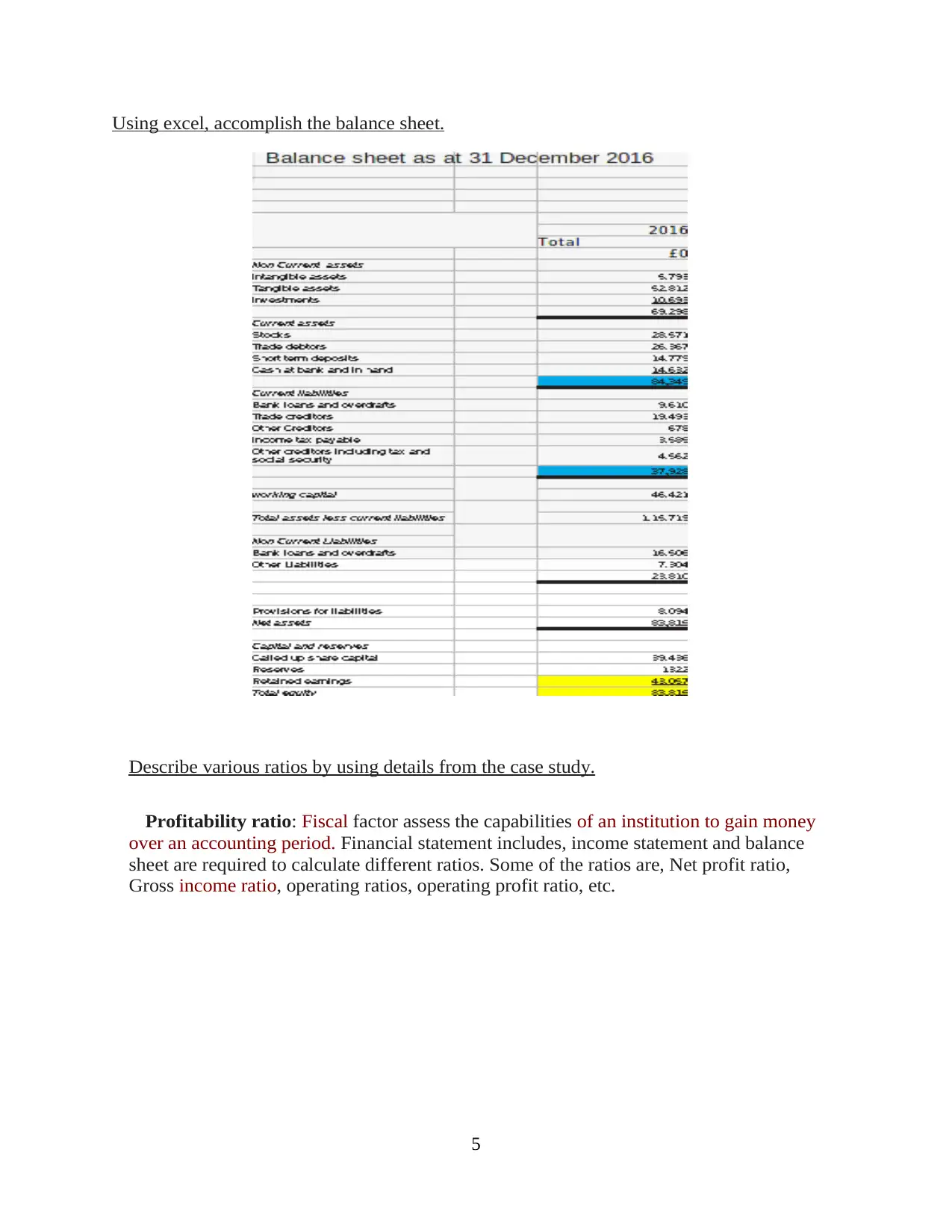
Using excel, accomplish the balance sheet.
Describe various ratios by using details from the case study.
Profitability ratio: Fiscal factor assess the capabilities of an institution to gain money
over an accounting period. Financial statement includes, income statement and balance
sheet are required to calculate different ratios. Some of the ratios are, Net profit ratio,
Gross income ratio, operating ratios, operating profit ratio, etc.
5
Describe various ratios by using details from the case study.
Profitability ratio: Fiscal factor assess the capabilities of an institution to gain money
over an accounting period. Financial statement includes, income statement and balance
sheet are required to calculate different ratios. Some of the ratios are, Net profit ratio,
Gross income ratio, operating ratios, operating profit ratio, etc.
5
⊘ This is a preview!⊘
Do you want full access?
Subscribe today to unlock all pages.

Trusted by 1+ million students worldwide
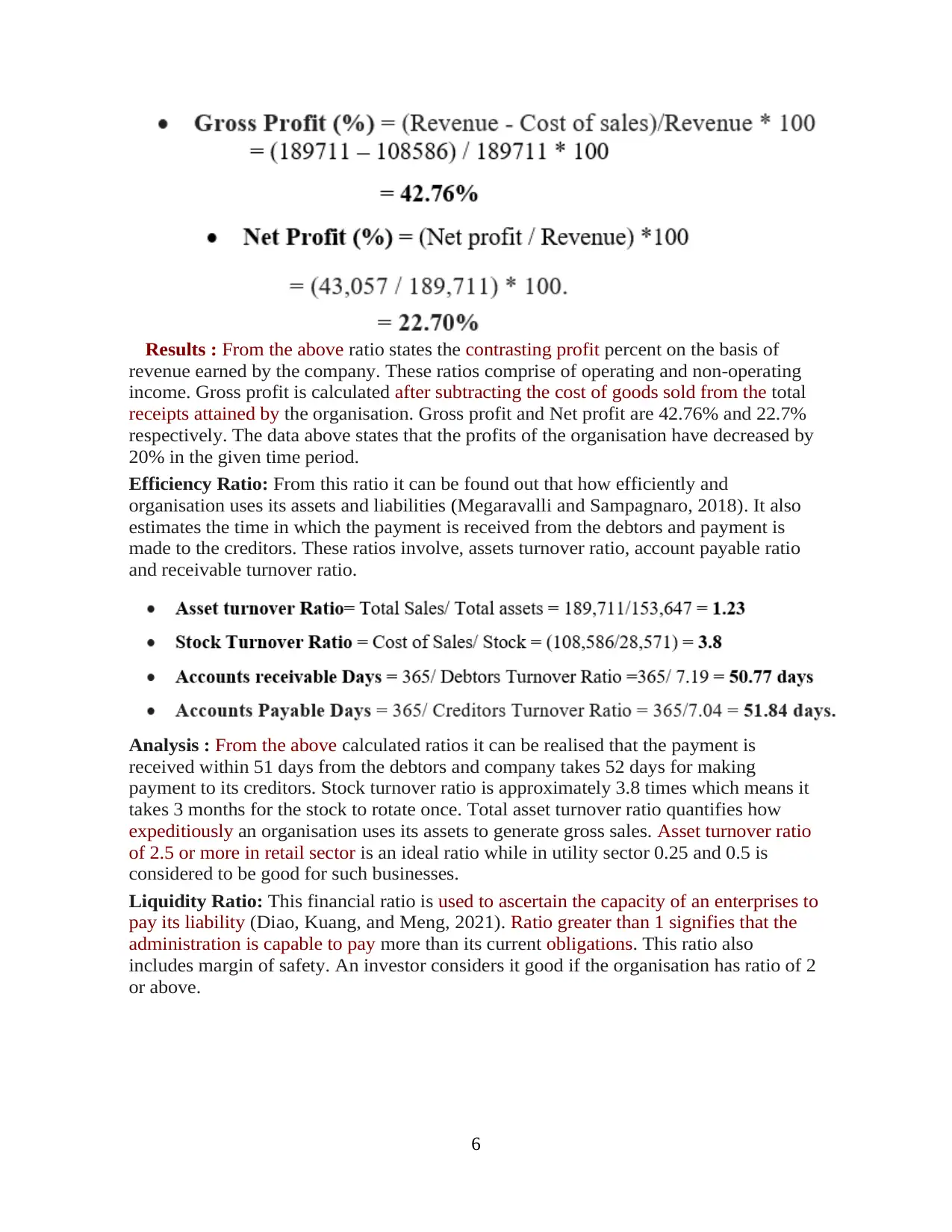
Results : From the above ratio states the contrasting profit percent on the basis of
revenue earned by the company. These ratios comprise of operating and non-operating
income. Gross profit is calculated after subtracting the cost of goods sold from the total
receipts attained by the organisation. Gross profit and Net profit are 42.76% and 22.7%
respectively. The data above states that the profits of the organisation have decreased by
20% in the given time period.
Efficiency Ratio: From this ratio it can be found out that how efficiently and
organisation uses its assets and liabilities (Megaravalli and Sampagnaro, 2018). It also
estimates the time in which the payment is received from the debtors and payment is
made to the creditors. These ratios involve, assets turnover ratio, account payable ratio
and receivable turnover ratio.
Analysis : From the above calculated ratios it can be realised that the payment is
received within 51 days from the debtors and company takes 52 days for making
payment to its creditors. Stock turnover ratio is approximately 3.8 times which means it
takes 3 months for the stock to rotate once. Total asset turnover ratio quantifies how
expeditiously an organisation uses its assets to generate gross sales. Asset turnover ratio
of 2.5 or more in retail sector is an ideal ratio while in utility sector 0.25 and 0.5 is
considered to be good for such businesses.
Liquidity Ratio: This financial ratio is used to ascertain the capacity of an enterprises to
pay its liability (Diao, Kuang, and Meng, 2021). Ratio greater than 1 signifies that the
administration is capable to pay more than its current obligations. This ratio also
includes margin of safety. An investor considers it good if the organisation has ratio of 2
or above.
6
revenue earned by the company. These ratios comprise of operating and non-operating
income. Gross profit is calculated after subtracting the cost of goods sold from the total
receipts attained by the organisation. Gross profit and Net profit are 42.76% and 22.7%
respectively. The data above states that the profits of the organisation have decreased by
20% in the given time period.
Efficiency Ratio: From this ratio it can be found out that how efficiently and
organisation uses its assets and liabilities (Megaravalli and Sampagnaro, 2018). It also
estimates the time in which the payment is received from the debtors and payment is
made to the creditors. These ratios involve, assets turnover ratio, account payable ratio
and receivable turnover ratio.
Analysis : From the above calculated ratios it can be realised that the payment is
received within 51 days from the debtors and company takes 52 days for making
payment to its creditors. Stock turnover ratio is approximately 3.8 times which means it
takes 3 months for the stock to rotate once. Total asset turnover ratio quantifies how
expeditiously an organisation uses its assets to generate gross sales. Asset turnover ratio
of 2.5 or more in retail sector is an ideal ratio while in utility sector 0.25 and 0.5 is
considered to be good for such businesses.
Liquidity Ratio: This financial ratio is used to ascertain the capacity of an enterprises to
pay its liability (Diao, Kuang, and Meng, 2021). Ratio greater than 1 signifies that the
administration is capable to pay more than its current obligations. This ratio also
includes margin of safety. An investor considers it good if the organisation has ratio of 2
or above.
6
Paraphrase This Document
Need a fresh take? Get an instant paraphrase of this document with our AI Paraphraser
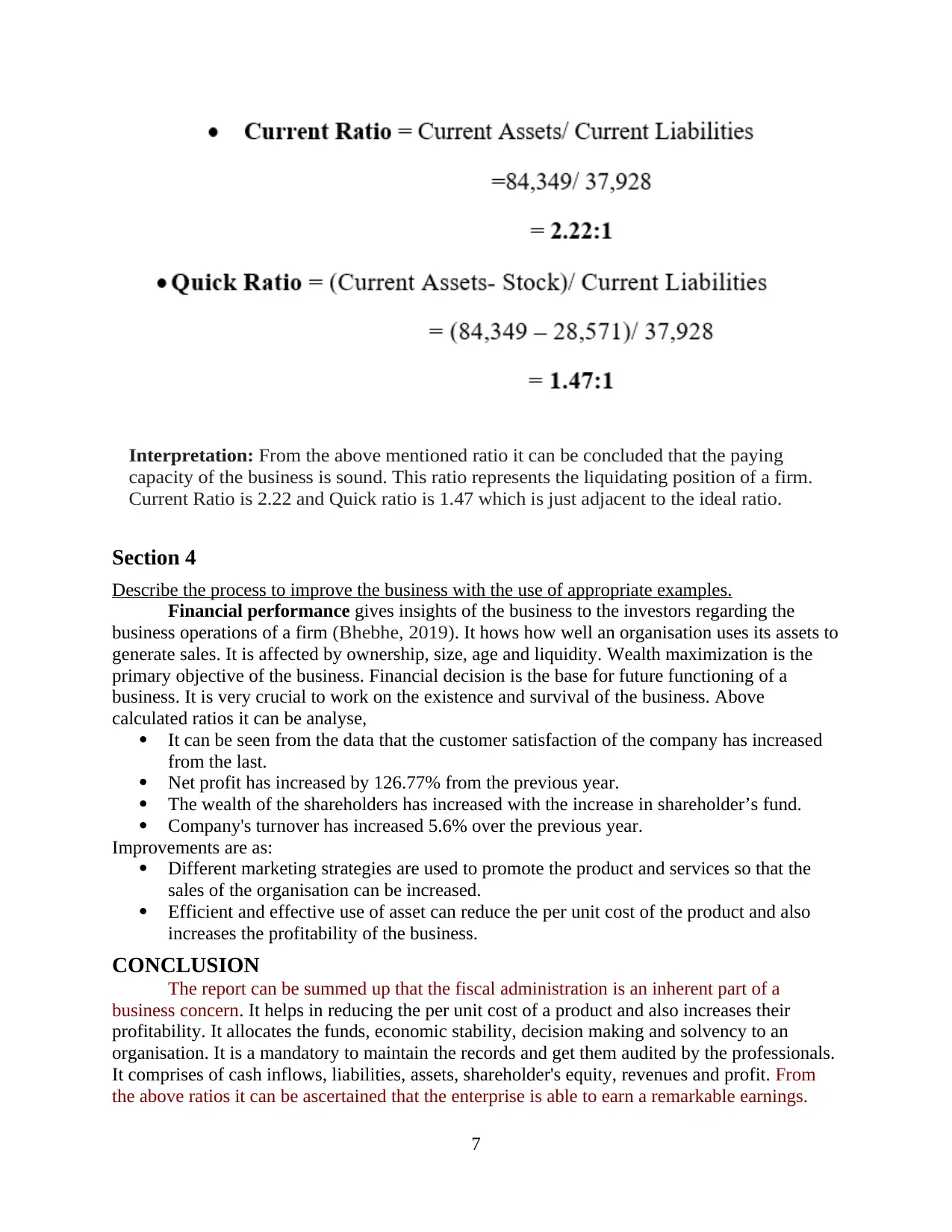
Interpretation: From the above mentioned ratio it can be concluded that the paying
capacity of the business is sound. This ratio represents the liquidating position of a firm.
Current Ratio is 2.22 and Quick ratio is 1.47 which is just adjacent to the ideal ratio.
Section 4
Describe the process to improve the business with the use of appropriate examples.
Financial performance gives insights of the business to the investors regarding the
business operations of a firm (Bhebhe, 2019). It hows how well an organisation uses its assets to
generate sales. It is affected by ownership, size, age and liquidity. Wealth maximization is the
primary objective of the business. Financial decision is the base for future functioning of a
business. It is very crucial to work on the existence and survival of the business. Above
calculated ratios it can be analyse,
It can be seen from the data that the customer satisfaction of the company has increased
from the last.
Net profit has increased by 126.77% from the previous year.
The wealth of the shareholders has increased with the increase in shareholder’s fund.
Company's turnover has increased 5.6% over the previous year.
Improvements are as:
Different marketing strategies are used to promote the product and services so that the
sales of the organisation can be increased.
Efficient and effective use of asset can reduce the per unit cost of the product and also
increases the profitability of the business.
CONCLUSION
The report can be summed up that the fiscal administration is an inherent part of a
business concern. It helps in reducing the per unit cost of a product and also increases their
profitability. It allocates the funds, economic stability, decision making and solvency to an
organisation. It is a mandatory to maintain the records and get them audited by the professionals.
It comprises of cash inflows, liabilities, assets, shareholder's equity, revenues and profit. From
the above ratios it can be ascertained that the enterprise is able to earn a remarkable earnings.
7
capacity of the business is sound. This ratio represents the liquidating position of a firm.
Current Ratio is 2.22 and Quick ratio is 1.47 which is just adjacent to the ideal ratio.
Section 4
Describe the process to improve the business with the use of appropriate examples.
Financial performance gives insights of the business to the investors regarding the
business operations of a firm (Bhebhe, 2019). It hows how well an organisation uses its assets to
generate sales. It is affected by ownership, size, age and liquidity. Wealth maximization is the
primary objective of the business. Financial decision is the base for future functioning of a
business. It is very crucial to work on the existence and survival of the business. Above
calculated ratios it can be analyse,
It can be seen from the data that the customer satisfaction of the company has increased
from the last.
Net profit has increased by 126.77% from the previous year.
The wealth of the shareholders has increased with the increase in shareholder’s fund.
Company's turnover has increased 5.6% over the previous year.
Improvements are as:
Different marketing strategies are used to promote the product and services so that the
sales of the organisation can be increased.
Efficient and effective use of asset can reduce the per unit cost of the product and also
increases the profitability of the business.
CONCLUSION
The report can be summed up that the fiscal administration is an inherent part of a
business concern. It helps in reducing the per unit cost of a product and also increases their
profitability. It allocates the funds, economic stability, decision making and solvency to an
organisation. It is a mandatory to maintain the records and get them audited by the professionals.
It comprises of cash inflows, liabilities, assets, shareholder's equity, revenues and profit. From
the above ratios it can be ascertained that the enterprise is able to earn a remarkable earnings.
7
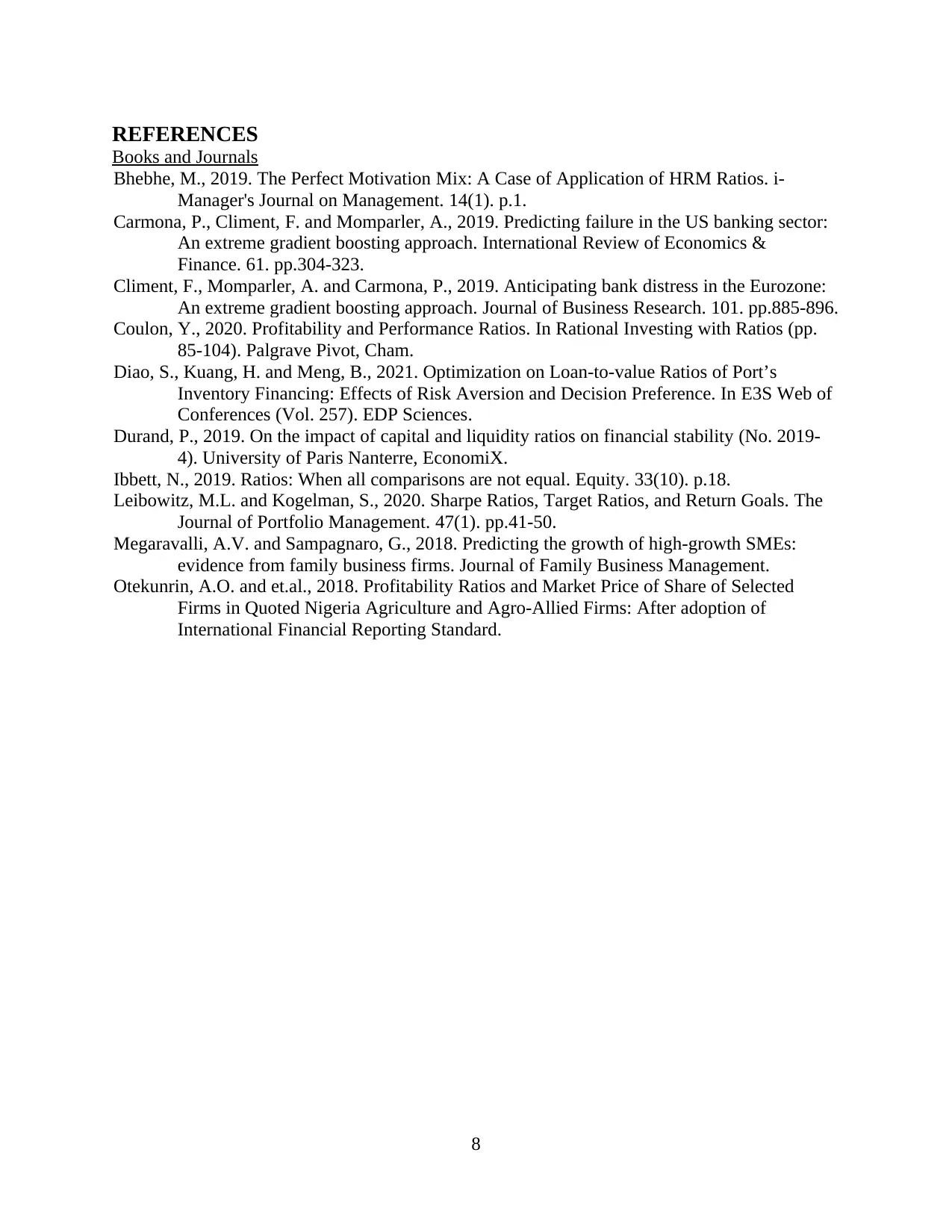
REFERENCES
Books and Journals
Bhebhe, M., 2019. The Perfect Motivation Mix: A Case of Application of HRM Ratios. i-
Manager's Journal on Management. 14(1). p.1.
Carmona, P., Climent, F. and Momparler, A., 2019. Predicting failure in the US banking sector:
An extreme gradient boosting approach. International Review of Economics &
Finance. 61. pp.304-323.
Climent, F., Momparler, A. and Carmona, P., 2019. Anticipating bank distress in the Eurozone:
An extreme gradient boosting approach. Journal of Business Research. 101. pp.885-896.
Coulon, Y., 2020. Profitability and Performance Ratios. In Rational Investing with Ratios (pp.
85-104). Palgrave Pivot, Cham.
Diao, S., Kuang, H. and Meng, B., 2021. Optimization on Loan-to-value Ratios of Port’s
Inventory Financing: Effects of Risk Aversion and Decision Preference. In E3S Web of
Conferences (Vol. 257). EDP Sciences.
Durand, P., 2019. On the impact of capital and liquidity ratios on financial stability (No. 2019-
4). University of Paris Nanterre, EconomiX.
Ibbett, N., 2019. Ratios: When all comparisons are not equal. Equity. 33(10). p.18.
Leibowitz, M.L. and Kogelman, S., 2020. Sharpe Ratios, Target Ratios, and Return Goals. The
Journal of Portfolio Management. 47(1). pp.41-50.
Megaravalli, A.V. and Sampagnaro, G., 2018. Predicting the growth of high-growth SMEs:
evidence from family business firms. Journal of Family Business Management.
Otekunrin, A.O. and et.al., 2018. Profitability Ratios and Market Price of Share of Selected
Firms in Quoted Nigeria Agriculture and Agro-Allied Firms: After adoption of
International Financial Reporting Standard.
8
Books and Journals
Bhebhe, M., 2019. The Perfect Motivation Mix: A Case of Application of HRM Ratios. i-
Manager's Journal on Management. 14(1). p.1.
Carmona, P., Climent, F. and Momparler, A., 2019. Predicting failure in the US banking sector:
An extreme gradient boosting approach. International Review of Economics &
Finance. 61. pp.304-323.
Climent, F., Momparler, A. and Carmona, P., 2019. Anticipating bank distress in the Eurozone:
An extreme gradient boosting approach. Journal of Business Research. 101. pp.885-896.
Coulon, Y., 2020. Profitability and Performance Ratios. In Rational Investing with Ratios (pp.
85-104). Palgrave Pivot, Cham.
Diao, S., Kuang, H. and Meng, B., 2021. Optimization on Loan-to-value Ratios of Port’s
Inventory Financing: Effects of Risk Aversion and Decision Preference. In E3S Web of
Conferences (Vol. 257). EDP Sciences.
Durand, P., 2019. On the impact of capital and liquidity ratios on financial stability (No. 2019-
4). University of Paris Nanterre, EconomiX.
Ibbett, N., 2019. Ratios: When all comparisons are not equal. Equity. 33(10). p.18.
Leibowitz, M.L. and Kogelman, S., 2020. Sharpe Ratios, Target Ratios, and Return Goals. The
Journal of Portfolio Management. 47(1). pp.41-50.
Megaravalli, A.V. and Sampagnaro, G., 2018. Predicting the growth of high-growth SMEs:
evidence from family business firms. Journal of Family Business Management.
Otekunrin, A.O. and et.al., 2018. Profitability Ratios and Market Price of Share of Selected
Firms in Quoted Nigeria Agriculture and Agro-Allied Firms: After adoption of
International Financial Reporting Standard.
8
⊘ This is a preview!⊘
Do you want full access?
Subscribe today to unlock all pages.

Trusted by 1+ million students worldwide
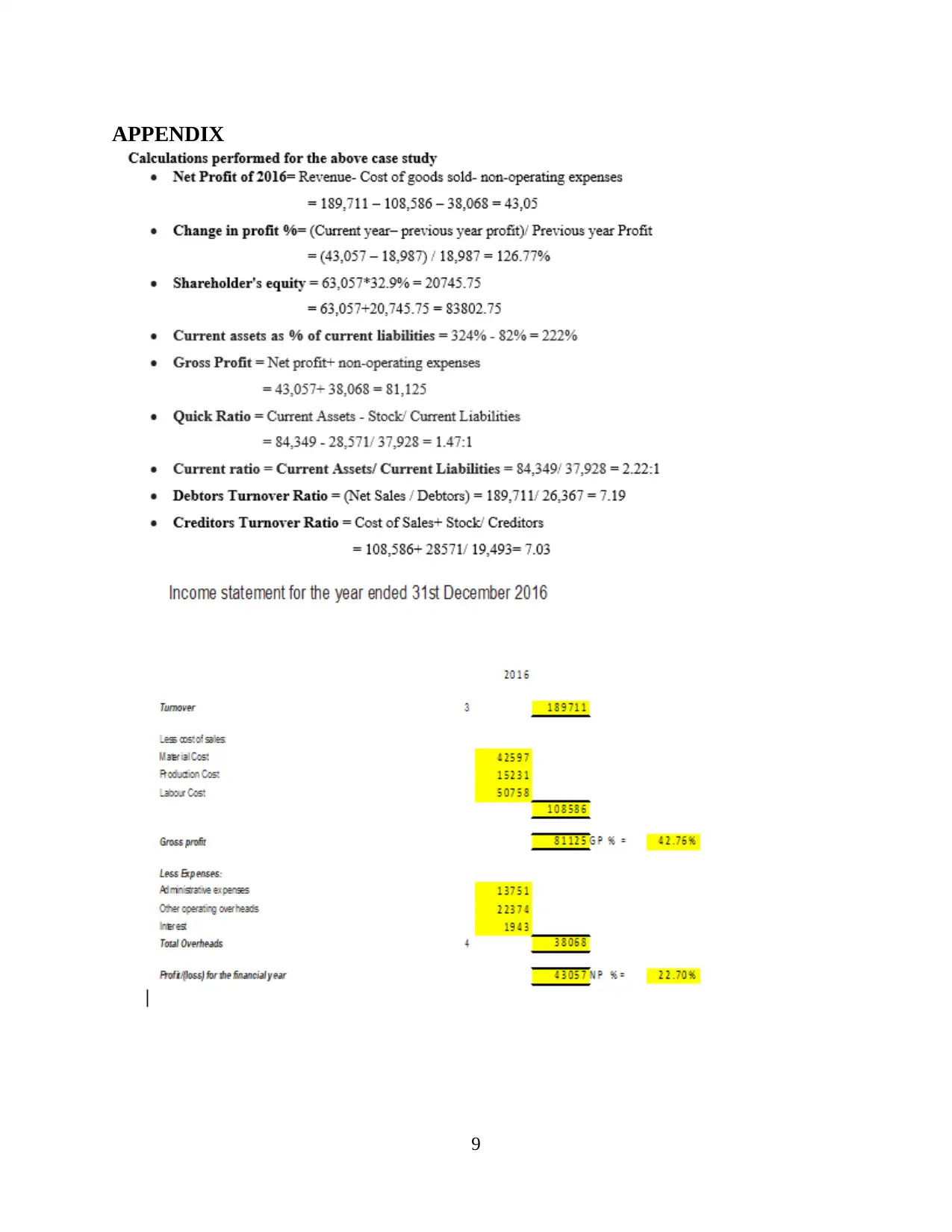
APPENDIX
9
9
1 out of 10
Related Documents
Your All-in-One AI-Powered Toolkit for Academic Success.
+13062052269
info@desklib.com
Available 24*7 on WhatsApp / Email
![[object Object]](/_next/static/media/star-bottom.7253800d.svg)
Unlock your academic potential
Copyright © 2020–2025 A2Z Services. All Rights Reserved. Developed and managed by ZUCOL.



